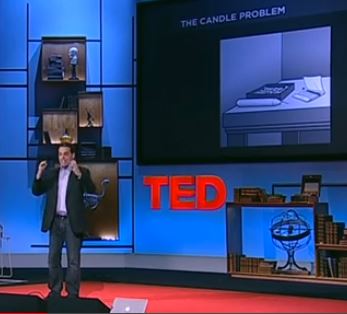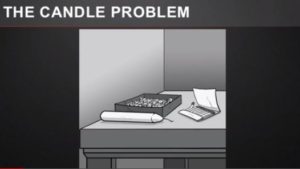This is the first in a series of 10 posts, looking at the public speaking lessons from each of the top 10-most viewed TED Talks.
Dan Pink: The Puzzle of Motivation
The Big Idea: Science has proven what business is only slowly realizing: Using incentives as rewards in business doesn’t work well for most tasks. In fact they can destroy creativity.
The overall construct of the speech: A persuasive speech using the construct of a lawyer presenting a case to a jury (the audience).
Not perfect: He used um as a filler word fairly often, about six times in just the first minute (and not so much after that). He also sometimes spoke using a pointing finger gesture, which can make some people feel like they are being scolded or talked down to. Sometimes he spoke so quickly that he seemed to get out of breath momentarily.
Conversational style of speaking: “Then they present all of the stuff that they’ve developed to their teammates . . .” “Stuff” may not be the most elegant word, but it’s how we talk.
Natural gestures: His gestures fit his emphatic personality, with his hands moving in rhythm to the cadence of his speech. He also used descriptive gestures (e.g. when he talked about having a narrow focus, he held up his hands like blinders on either side of his face). Some of his gestures were repetitive, but I didn’t find them distracting.
Attention-getting opening: “I need to make a confession . . .”
Humor at the start: four lines—all self-deprecating humor—got laughs in the first minute. One example: “I, in fact, graduated in the part of my law school class that made the top 90 percent possible.”
Global dexterity: He clarified meaning for the audience in Oxford, England: “Now, in America, law is a professional degree: you get your university degree, then you go on to law school.” He also used a “local” example: “Let’s go across the pond to the London School of Economics.”
Set the stage for persuasion: “I want to make a hard-headed, evidence-based, dare I say lawyerly case, for rethinking how we run our businesses.”
Gave the audience a role: “So, ladies and gentlemen of the jury, take a look at this.”
Engaged the audience intellectually and personally (by using “you” language): “Suppose I’m the experimenter. I bring you into a room. I give you a candle, some thumbtacks and some matches. And I say to you, ‘Your job is to attach the candle to the wall so the wax doesn’t drip onto the table.’ Now what would you do?”
Used visuals to enhance the audience’s imagination. The experiment is easier to imagine with a visual.
Acknowledged his own expertise, without tooting his own horn: “I spent the last couple of years looking at the science of human motivation, particularly the dynamics of extrinsic motivators and intrinsic motivators.”.
Sign-posted important points: “Let me tell you why this is so important.” Statements like this, if not overdone, get the listener to pay closer attention. He also said some things twice for emphasis. “Think about your own work. Think about your own work.” And, “And here’s the best part. Here’s the best part.” At the end, he was a bit obvious with “Let me wrap up” but it did frame the summary that followed as a summary.
Appealed to the audience’s own experience for validation of the concept: “Think about your own work. Are the problems that you face . . .”
Left us wanting more: In talking about a new “operating system for our businesses” he mentions three elements: autonomy, mastery and purpose. He then states “I want to talk today only about autonomy.” Very smart move if he has a book out with the other points, or wants to have people hire him to speak on the other points.
Supported his points with examples: “Let me give you some examples of some radical notions of self-direction.”
A line you can use when hardly anyone raises their hands: “Looks like less than half of you.” This is a funny line because even “less than half” is a gross exaggeration.
Your thoughts?


